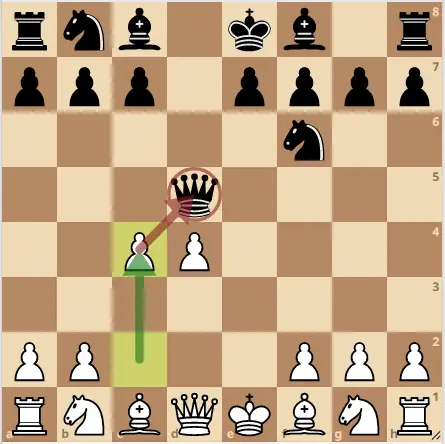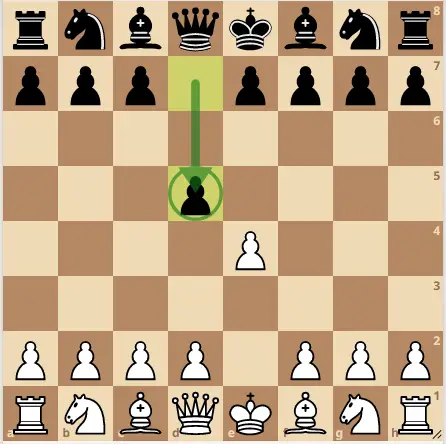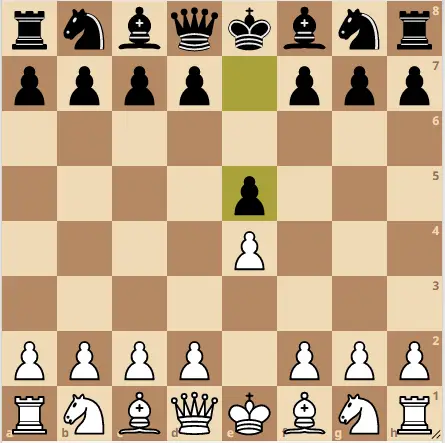An attack in chess is a move that threatens to capture an enemy piece usually on the next turn. You should always look for attacking moves in chess because it can lead to a material advantage. The best piece to attack is with your pawns. This is because they are only worth 1 point, and trading it off for another minor piece may grant you winning chances.
If you’re a beginner then you probably want to know how the pawns attack. Do they attack forward like the rook or queen? Here is what you should know:
Can Pawns Attack Forward?
A pawn cannot attack a piece forward that is one square directly in front of it . However, it may attack a piece diagonally forward to the left or right. Pawns capture diagonally forward, so if there is a piece present on that square, the pawn can attack or threaten to capture the piece on the next move.
A pawn can attack any piece on the chess board whether it be the king, queen, rook, bishop knight or another pawn.
The following diagram shows how the pawn moves forward and attacks the queen
Example 1: Pawn attacks queen by moving two squares forward

This position arises from the Scandinavian Defense. White advances his c pawn two squares forward to attack the black queen on d5. If Black doesn’t retreat his Queen from the d5 square, white will capture the queen on the next move as indicated by the red arrow.
To clear up any confusion, a pawn cannot attack or capture a piece that is directly in front of it. It can only blockade it. For example, the pawn on d4 in the above diagram cannot capture the black queen on d5, nor can it advance forward due to the blockade of the queen.
Can Pawns Attack Forward On First Move?
A pawn can attack diagonally forward on its first move. In fact, there are tons of positions where this can happen in the opening. For example, in the Scandinavian defense, white advances his e-pawn two squares forward. After which, black advances his d-pawn two squares forward to attack white’s e-pawn.
The Black pawn attacks forward on first move in the Scandinavian Defense

Black is threatening to win white’s valubale e pawn. White must respond accordingly and capture black’s d pawn which is the mainline of the opening.
Can Pawns Attack Backwards?
Unlike all the other pieces on the chess board, a pawn cannot move, attack or capture a piece backwards. It can only move one square forward or 2 squares forward on its first move, but never backwards.
Examples Of Pawn Attacking Diagonally Forwards
So far we’ve looked at how the pawn attacks the queen diagonally forwards in the Scandinavian Defense, but what about the other pieces? Does it attacks in them in the same fashion? Let’s look at some more examples.
Pawn attacks knight in Alekhine Defense
The pawns are known for attacking black’s knight in the Alekhine defense. The opening begins with the moves 1.e4 Nf6

The typical move for white here is to kick away the knight by advancing the e-pawn to the e5 square. From that square, the white pawn attacks the black knight and threatens to capture it diagonally forward to the right.
Black’s knight retreats to d4, after which white attacks the knight again with his c pawn. White is able to open lines and gain space in the center with tempo.
White attacks black’s knight diagonally forward

White can expand in the center with a 3rd pawn via pawn to d4. Though white has gained a lot of space and open lines for his pieces, black is actually doing fine here as his strategy will be to control the center from a far.
Pawn attacks bishop in Italian Opening
Another one of our examples features the Center attack of the Italian Classical Variation. White pushes forward his d pawn and lashes out in the center, attacking black’s bishop on c5.
Blockade Vs Attack
When you’re just starting to learn chess, it can be a bit confusing as to how the pawn captures. You just have to know the difference between a blockade and an attack.
When two pawns form a blockade, they cannot capture each other. A blockade is when a piece such as a pawn cannot advance forward due to the opposing piece blocking the path.
At the start of the chess game, white usually plays 1.e4 e5 which results in a blockade. This is called the King’s pawn game.
Blockade

Here, neither the white nor the black pawn can advance because they are in the way of each other. Most importantly, the white pawn cannot capture the black pawn because it is not diagonally to the left or right.
However, when we look at the Scandinavian defense as shown in the image below, the position is slightly different.
Attack

What do you notice?
Yes, the pawns are not blockading each other like in our previous example. The black pawn is diagonally left of the white pawn, which means that white can capture it on the next move.
Once you understand the difference between a blockade and an attack, things will start to make a lot of sense.
Pawns are not the only piece that can form a blockade. One of the best pieces to blockade is a knight, and it can be highly effective in the endgame phase of chess when you are trying to stop your opponent’s pawn from queening. You can learn more about pawn promotion here.
Final Verdict
Pawns are regarded as the soul of the chess game. They are what give the game it’s characteristics. They can dictate the pace of the game in closed or open positions. When it comes to attack, they can only capture diagonally forward one square to the left or right, but never a piece in front.
A piece that is in front of the pawn serves as a blockade which prevents the pawn from moving up the board. The piece blockading the pawn can never be captured by that pawn.


